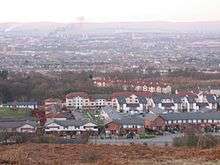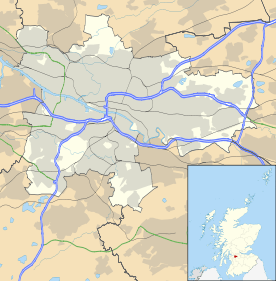Castlemilk
Coordinates: 55°48′11″N 4°14′06″W / 55.803033°N 4.235114°W
Castlemilk (Caisteal Mheilc in Gaelic) is a district of Glasgow, Scotland. It lies to the south of the city adjacent to Rutherglen (Spittal and Fernhill areas), Croftfoot, Simshill and the separate village of Carmunnock. Castlemilk House, a stately old mansion built around Cassilton Tower, which was started in 1460 on the site of a 13th-century castle, was demolished by Glasgow Corporation in December 1969. The area was developed by the Corporation as a peripheral housing scheme in the 1950s to accommodate 34,000 people from inner city slum areas such as the Gorbals. These people were provided with open spaces, a clean environment and indoor toilets and bathrooms.
The population had dropped from 37,000 in 1971 to roughly half that number in 1991. However, despite the social problems associated with poverty and unemployment, the area has seen the benefits of a regeneration strategy implemented in the 1980s which has focused on improved housing and the development of local arts. Community groups and Cooperative housing associations have done a lot to regenerate the housing and improve the amenities for local people. A swimming pool, sports centre, shopping arcade and community centres have been developed.
Early History

(Taken from "The Incomplete History Of Castlemilk" by the Castlemilk History Group). Carmunock did not escape the religious turbulence of the years following Mary Queen of Scots flight to and later imprisonment in England. While Carmunnock church remained with the Established Church, several of its ministers fought for the National Covenant. The Rev James Mowbrae was dismissed in 1639; his successor Rev Matthew McKail was transferred to Bothwell in 1649, while Rev Andrew Morton was also dismissed for non-conformity in 1662. Rev Morton was to return in 1687 upon the decline of the rule of bishops. According to Mrs Herbert (Author of the History of Carmunnock), 'The villagers, joyfully taking the opportunity, forcibly threw the unpopular Rev Mr Boyd out of the manse'.
Over this period the Stuarts added to their estate. Again confusion surrounds the date in history of the Stuart connection with Cassiltoun. According to some sources, the Stuarts sold their Dumfriesshire estate of Castlemilk to Lord Maxwell in 1579, and from that date the Lanarkshire property of Cassiltoun became known as Castlemilk. Other sources give the date of this development as 1759. Certainly in writing up his Statistical Account of the parish in 1796 the Rev Adam Forman seemed comfortable in his use of the term Castlemilk for the former estate of Cassiltoun.
This period saw further additions to the Stuart fortunes through their links with the parish of Torrance and the estate of Milton. Torrance House (in present-day Calderglen Park, East Kilbride) was built in 1605 and sold to the Stuarts of Castlemilk in 1650. It remained with the Stuarts until 1947, when it was acquired by the East Kilbride Development Corporation as their Headquarters. During the 18th Century, the valuable estate of Milton on the north side of Glasgow came by marriage into the possession of the family. It included a large area north of Cowcaddens and Parliamentary Road, Hyndland, Barmulloch and Barlornock, besides the site of the present large housing scheme of Milton. In 1706 a deed of entail was obtained, obliging every future holder of the Milton estate to assume the name of Crawfurd.

This fact, coupled with inter-marriage with the Stirlings of Keir and the failure of the Stuart male line in 1797 explains the present family name of Crawfurd Stirling Stuart. This complex family history was explored by Andrew Stuart of Torrance and Castlemilk who published The History of the Genealogy of the Stewarts in 1798.[1]
In 1991, in advance of the redevelopment of the site of Castlemilk House into an adventure playground, an archaeological dig was carried out by Archaeology Projects Glasgow in close collaboration with the now defunct Castlemilk Local History Group. Two trial trenches to the west of the tower discovered a defensive ditch which had been filled with midden material such as pottery, bone, bottle glass and a clay pipe bowl that would date the deposit to the 18th century if not earlier. The remains of a stone structure which could have been a possible bridge was also uncovered running across the line of the ditch. Other trial trenches produced very little of interest.[2]
Development of the modern estate
Castlemilk and the other peripheral housing schemes in Glasgow had their origins in the city’s housing crisis after the end of the Second World War. Many inner city areas contained street after street of sub-standard tenement housing and the city as a whole had a shortage of affordable good quality accommodation.

In 1947 a delegation from Glasgow visited Marseille to see the new social housing designed by the Swiss-French architect Le Corbusier, who was a pioneer of modern urban planning. The group examined how his ideas could be applied to Glasgow with the proposed development of new “townships” on the outskirts of the city. Around the same time a second strategy was also formulated for the dispersal of the city's population, this being new towns such as East Kilbride (which is only a few miles across countryside from Castlemilk). However the city fathers were anxious to ensure that most people remained living within the Glasgow boundaries so they keenly pursued the townships project. The other areas identified for this were Pollok, Drumchapel and Easterhouse - collectively referred to along with Castlemilk as 'the big four'. In December 1952, Glasgow Corporation approved a sketch layout plan for the construction of a new township at Castlemilk with an estimated cost of £16m. It was planned to ultimately comprise some 8,300 houses.[3] In early 1953 more detailed plans for the development of Castlemilk were prepared by Archibald George Jury, who had been appointed as Glasgow’s first City Architect in 1951, a post he held until his retirement in 1972.
There was a very limited range of different house types planned for the initial Castlemilk scheme. Most of the accommodation was to be contained in 3 or 4-storey tenement blocks. There were also to be 3-storey terraced houses intended for larger families and a few other house types designed for the elderly and other groups such as the local fire service personnel. The original 1950s flats, entered from common closes, seem to have been designed as modern versions of the traditional Glasgow tenements. Unlike many of the Victorian tenement dwellings, however, these flats came with interior bathrooms and hot and cold water.

The multi-storey blocks in Castlemilk did not arrive until the 1960s. Archibald Jury was the architect responsible for the creation of the three 20-storey tower blocks in Dougrie Road, from the planning stage in 1960 to their completion in 1966.[4] The Mitchelhill high-rise blocks at Ardencraig Road were designed and built by George Wimpey Ltd, between 1963 and 1965, Wimpey was also responsible for the construction of Bogany Flats in 1966.[5]
Public housing policy in Scotland was radically changed by the Tenants' Rights, Etc. (Scotland) Act 1980, which gave tenants the right to buy their council houses for the first time. Since then, renovation, demolition and refurbishment of Castlemilk’s existing housing stock has taken place, as well as the development of areas of new build houses for owner-occupation. Tenure has diversified with home ownership transferred from the City Council to local Housing Associations and owner-occupiers.

The township centre at Castlemilk Arcade / Dougrie Drive was developed by Ravenseft Properties Ltd between 1961 and 1963[6] on a 5-acre (20,000 m2) site which was formerly the location of the large country houses at Castleton, west of Castlemilk House. The centre was designed to contain about 60 shops at an estimated cost of £3m to £4m.[7] The shops are still standing, with an 80% occupancy rate. The centre now contains Castlemilk’s one and only pub, the Oasis, in Dougrie Drive.
The original neighbourhood shops were built at the ground floors of the tenement blocks, following the old Glasgow pattern. Ownership of these small shops has been transferred from the Council to the Glasgow Housing Association, who have let the surviving blocks of shops in Stravanan Road, Tormusk Road and Machrie Road to various tenants.
In 2001, the Reverend John D. Miller, minister of Castlemilk East Parish Church (from 1971 until his retirement in 2007), was elected Moderator of the General Assembly of the Church of Scotland. Miller Primary School in Castlemilk was named after him and his wife.
Notable residents
- Ikechi Anya, footballer[8]
- Darren Brady, footballer[9]
- Garry Brady, footballer[9]
- Islam Feruz, footballer[10]
- Arthur Graham, footballer[11]
- Eddie Gray, footballer[12]
- Frank Gray, footballer[13]
- Dave King, businessman[14]
- Frank Gray, footballer[13]
- Ray Houghton, footballer[15]
- Sir Stephen House, Chief Constable of Police Scotland.[16]
- Rory Hughes, rugby[17]
- Gary Lamont, actor[18]
- Frank Maguire, lawyer[19]
- James McCarthy, footballer[20]
- Paul McCole, actor[21]
- Stephen McCole, actor[22]
- Aiden McGeady, footballer[23]
- Jim McInally, footballer[24]
- Andy McLaren, footballer[25]
- Charlie Miller, footballer[24]
- Bernie Slaven, footballer[26]
- Derek Forbes, bassist with Simple Minds
References
- ↑ Incomplete History Of Castlemilk, Chapter3
- ↑ RCAHMS web site
- ↑ The Builder, 5 Dec 1952, p852
- ↑ The Builder, 17 June 1960, p1168
- ↑ The Buildings of Scotland, Glasgow p531
- ↑ The Builder, 10 February 1961, p295-296
- ↑ The Builder, 16 June 1961, p1176
- ↑ "Ikechi Anya: From Castlemilk to Scotland squad". scotsman.com.
- 1 2 "I did OK in grand scheme of things; BROTHERS KEPT CASTLEMILK BOY DARREN BRADY ON COURSE.". thefreelibrary.com.
- ↑ Walker, Michael (22 October 2009). "Scotland's symbol of hope: How 14-year-old Feruz went from refugee to a star in the making". Daily Mail. Retrieved 1 March 2014.
- ↑ "Leeds United: My Whites playing days - Arthur Graham INTERVIEW". Yorkshire Evening Post.
- ↑ "This Life: Eddie Gray". Yorkshire Evening Post.
- 1 2 "Eddie and Frank Gray : Local News Glasgow". localnewsglasgow.co.uk.
- ↑ "The man who would be King – South African the favourite to take over Rangers". Herald Scotland.
- ↑ "SCOT WHO BECAME AN IRISH WORLD CUP HERO THE ARCHIVE RAY HOUGHTON". Herald Scotland.
- ↑ "Interview: Stephen House, Scotland's top policeman". scotsman.com.
- ↑ "Rory Hughes ready to deliver on Scotland debut". scotsman.com.
- ↑ Marion Scott (29 January 2012). "Scots actor Gary Lamont tells of his heartbreak over the knife death of friend". dailyrecord.
- ↑ "Campaigning lawyer loses fight for life". Herald Scotland.
- ↑ Craig McQueen (4 September 2013). "Scotland's most expensive - and down to earth - footballer James McCarthy buys £1m luxury home for his parents". dailyrecord.
- ↑ Paul English (27 June 2008). "High Times duo Stephen and Paul McCole find fame in unlikely places". dailyrecord.
- ↑ "Stephen McCole interview: Life imitating comedy". scotsman.com.
- ↑ John Fallon (9 September 2014). "Steven Naismith: Aiden McGeady can exploit Germany". irishmirror.
- 1 2 "The man who wants to put football back on the map". Herald Scotland.
- ↑ dailyrecord Administrator (21 April 2009). "Andy McLaren – to hell and back". dailyrecord.
- ↑ "BBC News - SCOTLAND - Ex-soccer star bids to be mayor". bbc.co.uk.
External links
- Castlemilk, Origins and History Maps and Photographs
- Castlemilk History MySpace
- CANMORE page showing historical photographs of Castlemilk House
- Castlemilk History Facebook This is the most up-to-date information for Castlemilk History...
